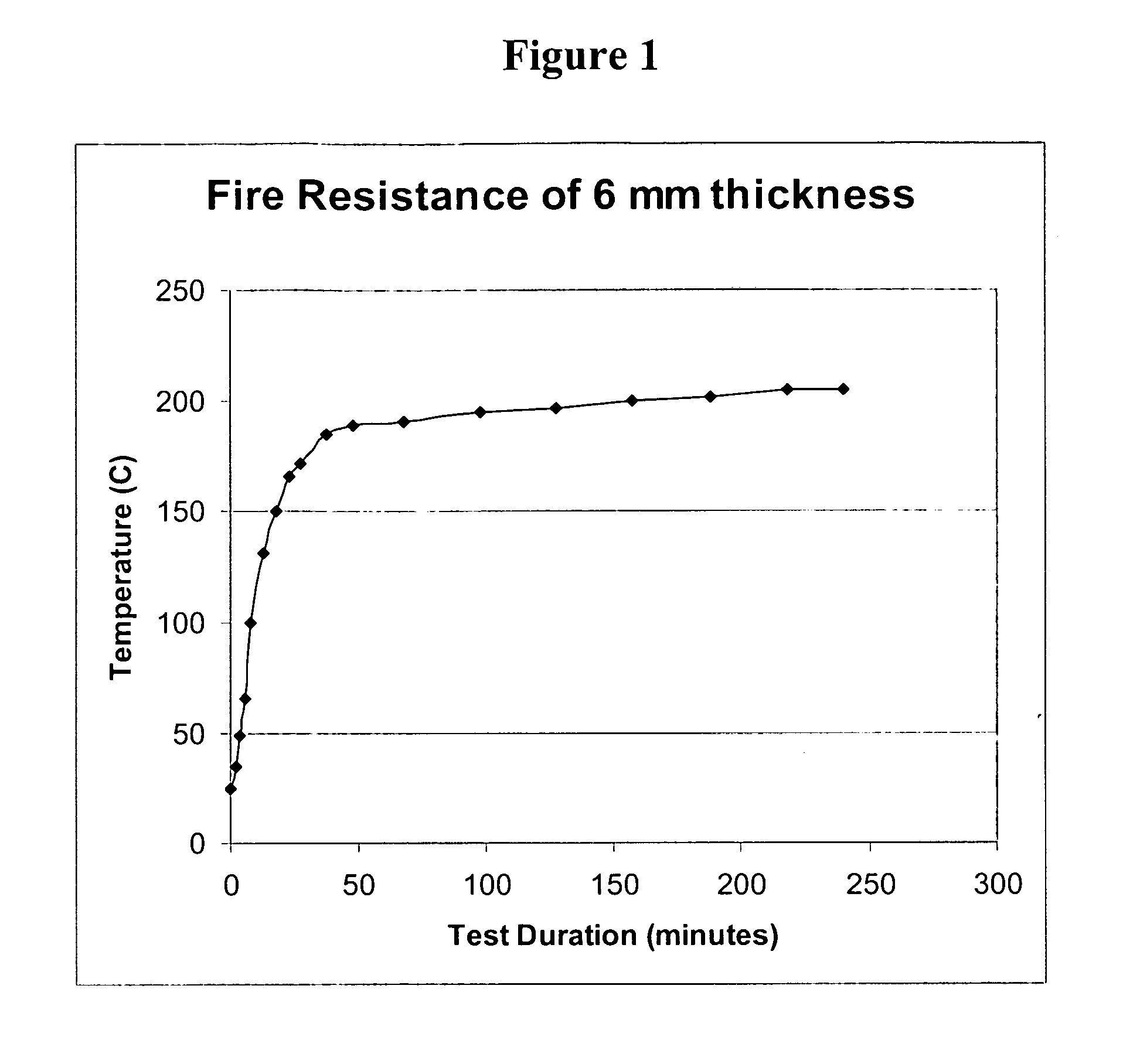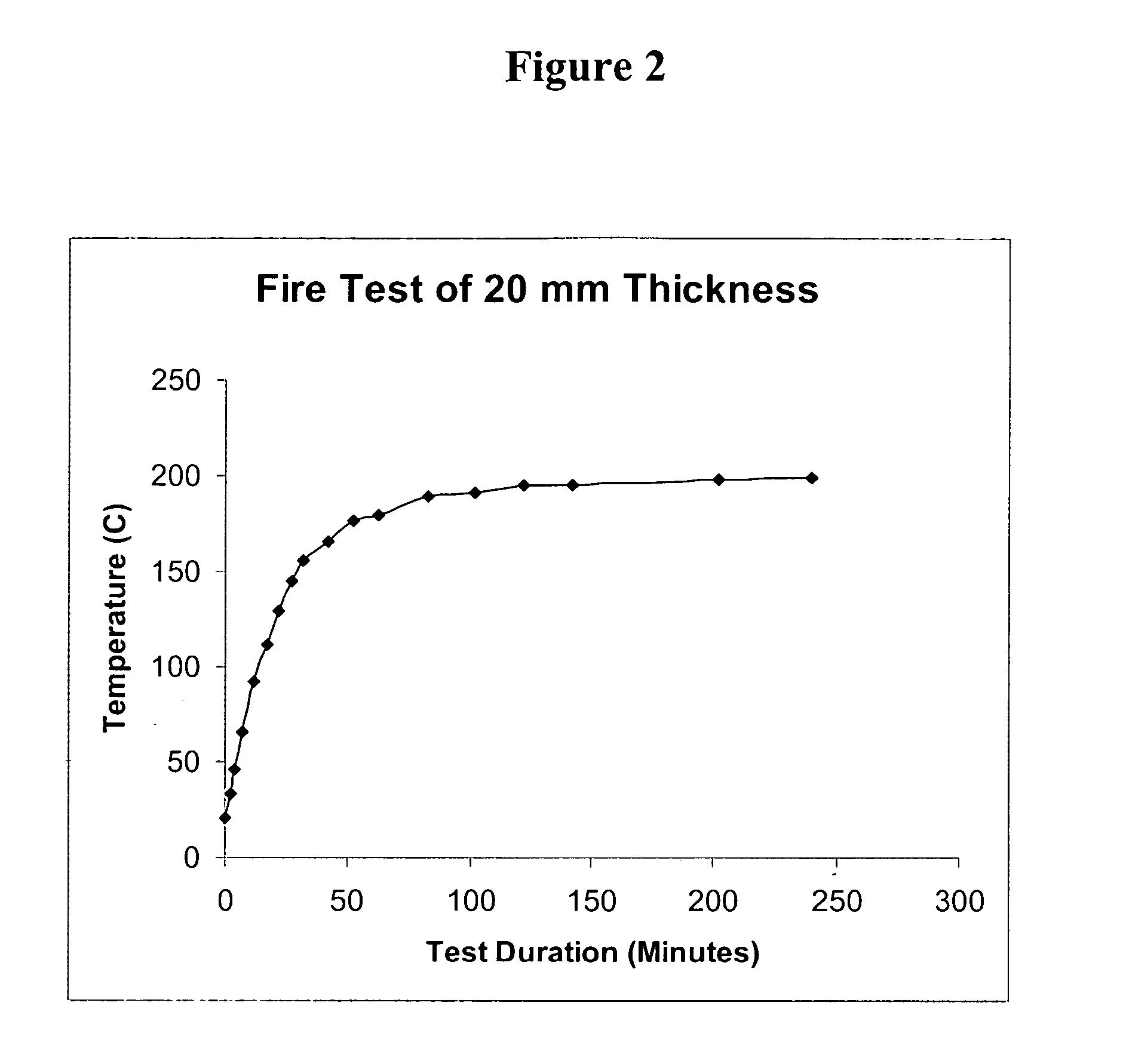Method for protecting surfaces from effects of fire
- Summary
- Abstract
- Description
- Claims
- Application Information
AI Technical Summary
Benefits of technology
Problems solved by technology
Method used
Image
Examples
example i
[0075] A fire resistance composition of polydiorganodisiloxane was prepared in two parts.
Part A
[0076] Part A of the formulation was prepared by mixing 44 percent by weight of polydimethyl siloxane terminated by vinyl radical (CH2═CH—), of viscosity 10,000 centipoise with 4 percent by weight of amorphous silica having a surface area of 150 m2 / g treated with hexamethyldisilazane, 10 percent by weight of crystalline silica and 34 percent by weight of melamine. Then 8 percent by weight of organoplatinum catalyst was added and mixed until the mixture was a flowable homogenous paste.
Part B
[0077] Part B of the formulation was prepared by mixing 85 percent by weight of polydimethyl siloxane terminated by vinyl radical with 8 percent by weight of amorphous silica having a surface area of 150 m2 / g treated with hexamethyl disilazane, 4 percent by weight of polydimethyl siloxane crosslinker having 20 mole percent of methyl radical substituted with hydride radical. Then 2 percent by weight...
example ii
[0080] A composition useful for fire resistance was prepared by mixing 38 parts by weight of polydimethylsiloxane terminated by hydroxyl groups having a viscosity of 3,300 centipoise at 25° C., with 10 parts by weight of titanium dioxide of specific gravity of 4, 8 parts by weight of melamine of density 1.5 g / ml and 38 parts by weight of mixture of amorphous and crystalline silica fillers the amorphous silica having a specific gravity of 2.2 and a surface area of 150 m2 / g. Then 4 parts by weight of methyl tris-(methyl ethyl ketoxime) silane, 1 part by weight of N-(2-aminoethyl-3 aminopropyl)trimethoxysilane and 0.1 part by weight of dibutyltin dilaurate are added under a nitrogen atmosphere and mixed well under the nitrogen atmosphere to uniform consistency.
[0081] A sheet of silicone of uniform thickness (6 mm) was prepared in a mould and cured at room temperature and 50% relative humidity for 7 days.
example iii
UL 94V Flammability Test Procedure
[0082] A UL 94V test was conducted to predict the flammability rating of the cured silicone product prepared in accordance with the above examples. The material can be classified V-1, V-1 or V-2 on the basis of results.
[0083] Bar shape pieces of size 125 mm×13 mm were cut from the 6 mm sheets prepared in accordance with Example II above. The edges were rounded to smooth shape.
[0084] Methane gas supply to a burner was adjusted to a flow rate of 105 mL / minute. The burner was adjusted to produce a 20 mm blue flame. The bar sample was clamped vertically such that the top of the burner was 10 mm below the lower end of the specimen. The flame was applied at the center point of the lower end of the specimen bar. The flame was applied for 10 seconds and then moved away to a distance of 150 mm from the specimen. The time of the after flame (t1) was recorded. As soon as after flaming ceases the burner was placed immediately under the specimen at a distanc...
PUM
| Property | Measurement | Unit |
|---|---|---|
| Fraction | aaaaa | aaaaa |
| Percent by mass | aaaaa | aaaaa |
| Length | aaaaa | aaaaa |
Abstract
Description
Claims
Application Information
 Login to View More
Login to View More - R&D
- Intellectual Property
- Life Sciences
- Materials
- Tech Scout
- Unparalleled Data Quality
- Higher Quality Content
- 60% Fewer Hallucinations
Browse by: Latest US Patents, China's latest patents, Technical Efficacy Thesaurus, Application Domain, Technology Topic, Popular Technical Reports.
© 2025 PatSnap. All rights reserved.Legal|Privacy policy|Modern Slavery Act Transparency Statement|Sitemap|About US| Contact US: help@patsnap.com



